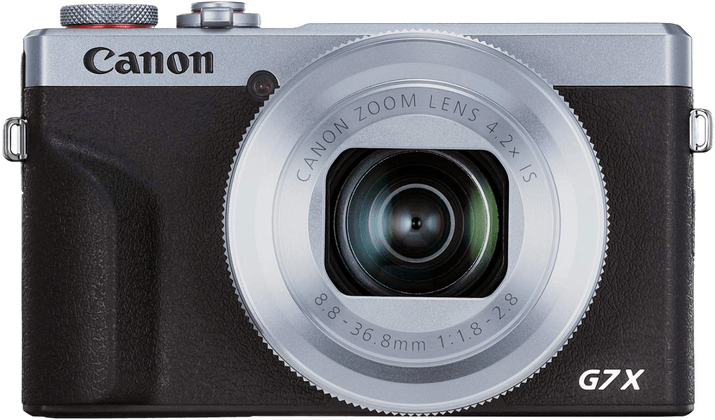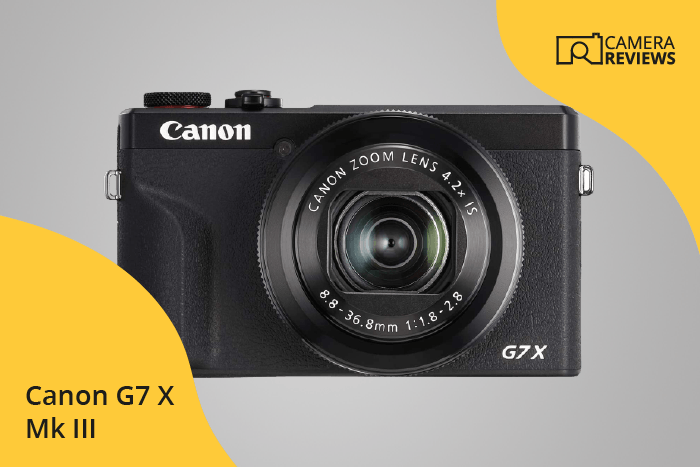Canon PowerShot G7 X Mark III Specs and Scores

The Canon PowerShot G7 X Mark III receives a score of 59/100. This compact camera, announced on July 9, 2019, and released the same year, is priced at $749. With dimensions of 105 x 61 x 41mm and a weight of 304g (0.67lbs), the G7 X Mark III has decent specifications for today’s market.
While the score doesn’t make the camera better, it reflects the camera’s performance and features. The Canon PowerShot G7 X Mark III offers a solid option for those seeking a compact, user-friendly camera.
Canon PowerShot G7 X Mark III Overview and Optics
The optics of the Canon PowerShot G7 X Mark III receive a score of 57 out of 100. This camera features a 20-megapixel sensor, 30 fps shooting speed, and a CMOS sensor. The Digic 8 processor powers the device, and it has a DXOMARK sensor score of 58. The 1″ sensor size is relatively common in today’s market, and the 3:2 aspect ratio is a standard choice for many cameras.
This camera comes with a fixed lens mount, meaning that users cannot change the lens. However, it does offer image stabilization, which is a valuable feature for capturing clear images. The inability to change lenses may limit the camera’s versatility, but its other specifications make it a solid choice for casual and semi-professional photography.
Considering the optics specifications of the Canon PowerShot G7 X Mark III, it is a decent camera for its target audience. While it may not compete with high-end DSLRs, it holds its own among compact cameras and offers reliable performance for various photography needs.
Canon PowerShot G7 X Mark III Video Performance
The Canon PowerShot G7 X Mark III boasts an impressive video score of 91/100. Its video capabilities include a maximum resolution of 4K (3840 x 2160) and a maximum frame rate of 120fps, which allows for stunning, high-quality footage. Additionally, this camera features built-in time-lapse functionality, enhancing its creative potential.
In comparison to other cameras on the market, the G7 X Mark III’s video specifications stand strong, offering competitive video quality and features. With its high-resolution and fast frame rate, it caters to both casual users and professional videographers alike.
The Canon PowerShot G7 X Mark III proves itself as a top contender in the realm of video capabilities, providing users with exceptional performance and versatility. Its high video score is well-deserved and reflects the camera’s outstanding quality.
Canon PowerShot G7 X Mark III Features and Benefits
The Canon PowerShot G7 X Mark III receives a feature score of 70/100. This camera boasts a 3-inch screen with a resolution of 1,040,000 dots. It offers a touchscreen for easy navigation and a flip screen for versatile shooting angles. However, the G7 X Mark III lacks GPS capabilities.
In today’s market, the G7 X Mark III holds its own with its screen size and resolution, as well as its touchscreen and flip screen features. The absence of GPS might be a drawback for some users, but the camera compensates with its WiFi and Bluetooth connectivity options.
Considering the features, the Canon PowerShot G7 X Mark III proves to be a reliable camera, with a decent score of 70/100. Its versatile screen and connectivity options make it a worthy contender in the market.
Canon PowerShot G7 X Mark III Storage and Battery
The Canon PowerShot G7 X Mark III receives a storage and battery score of 27/100. It has one memory card slot that accepts SD, SDHC, and SDXC cards, with compatibility for UHS-I cards. In the current market, a single card slot is common for compact cameras, but may not be sufficient for professionals who require multiple cards for backup purposes.
The camera’s battery life is 235 shots per charge, utilizing an NB-13L battery. This battery life may be considered short for some users, especially when compared to other cameras in the market. However, the G7 X Mark III does offer USB charging, providing a convenient way to recharge the battery on-the-go.
Despite the low score in this section, the Canon PowerShot G7 X Mark III remains a solid choice for casual photographers who can manage with one memory card slot and a shorter battery life. The USB charging option adds flexibility for those who need to recharge while out and about.
Canon PowerShot G7 X Mark III Alternatives
Do you want to know how the Canon PowerShot G7 X Mark III compares to its competitors? Have a look at the most popular comparisons for this camera below:
- Canon PowerShot G7 X Mark III vs Sony Cyber-shot DSC-RX100 VII
- Canon PowerShot G7 X Mark II vs PowerShot G7 X Mark III
- Canon PowerShot G5 X Mark II vs PowerShot G7 X Mark III
- Canon PowerShot G7 X Mark III vs Panasonic Lumix ZS200 (TZ200)
- Canon PowerShot G7 X Mark III vs Ricoh GR IIIx
- Canon PowerShot G7 X Mark III vs Sony ZV-E10
Canon PowerShot G7 X Mark III FAQ
Does the Canon PowerShot G7 X Mark III Have Built-in Image Stabilization?
Yes, the Canon PowerShot G7 X Mark III features built-in image stabilization, which helps to reduce camera shake and ensure sharp images and smooth videos.
Does the Canon PowerShot G7 X Mark III Support 4K Video Recording?
Yes, the Canon PowerShot G7 X Mark III supports 4K video recording, allowing users to capture high-quality, detailed footage with ease.
What Size Sensor Does The Canon PowerShot G7 X Mark III Have?
The Canon PowerShot G7 X Mark III has a 1-inch sensor, providing improved image quality and low-light performance compared to smaller sensors.
Does the Canon PowerShot G7 X Mark III Have a Dual Memory Card Slot?
No, the Canon PowerShot G7 X Mark III has a single memory card slot, which supports SD, SDHC, and SDXC cards.
Does the Canon PowerShot G7 X Mark III Have a Touch Screen?
Yes, the Canon PowerShot G7 X Mark III features a touch screen, making it easy to navigate menus, adjust settings, and focus on subjects.
Does the Canon PowerShot G7 X Mark III Have Wi-Fi and Bluetooth?
Yes, the Canon PowerShot G7 X Mark III has both Wi-Fi and Bluetooth capabilities, allowing for easy image transfer and remote control via compatible devices.
Does the Canon PowerShot G7 X Mark III Have GPS?
No, the Canon PowerShot G7 X Mark III does not have built-in GPS. However, you can use the camera’s Wi-Fi and Bluetooth features to sync location data from a compatible smartphone.
Is the Canon PowerShot G7 X Mark III Weather Sealed?
No, the Canon PowerShot G7 X Mark III is not weather sealed, so it’s important to protect the camera from moisture and dust during use.
Does the Canon PowerShot G7 X Mark III Have a Built-in Flash?
Yes, the Canon PowerShot G7 X Mark III has a built-in flash, which can provide extra light when needed in low-light situations.

